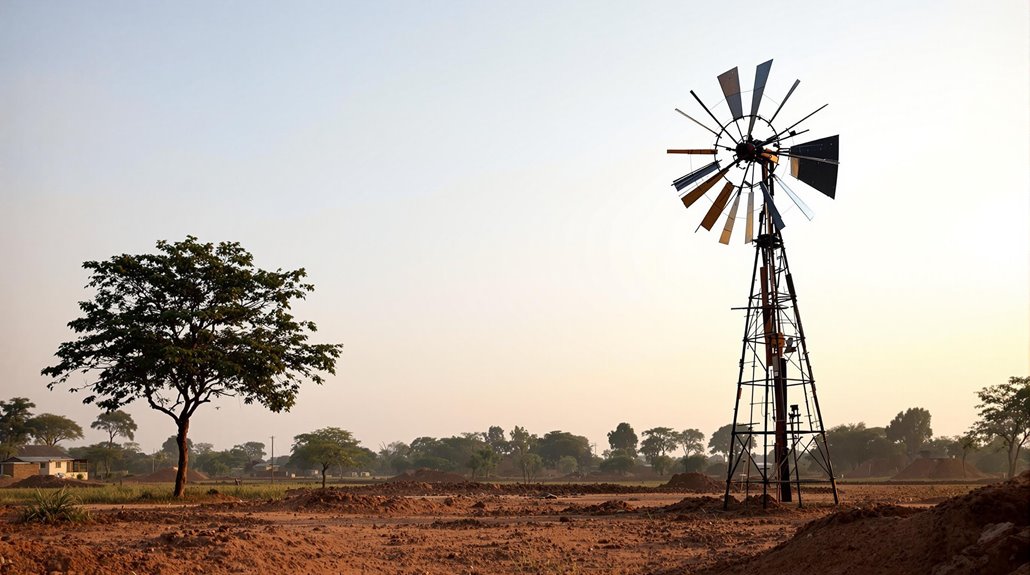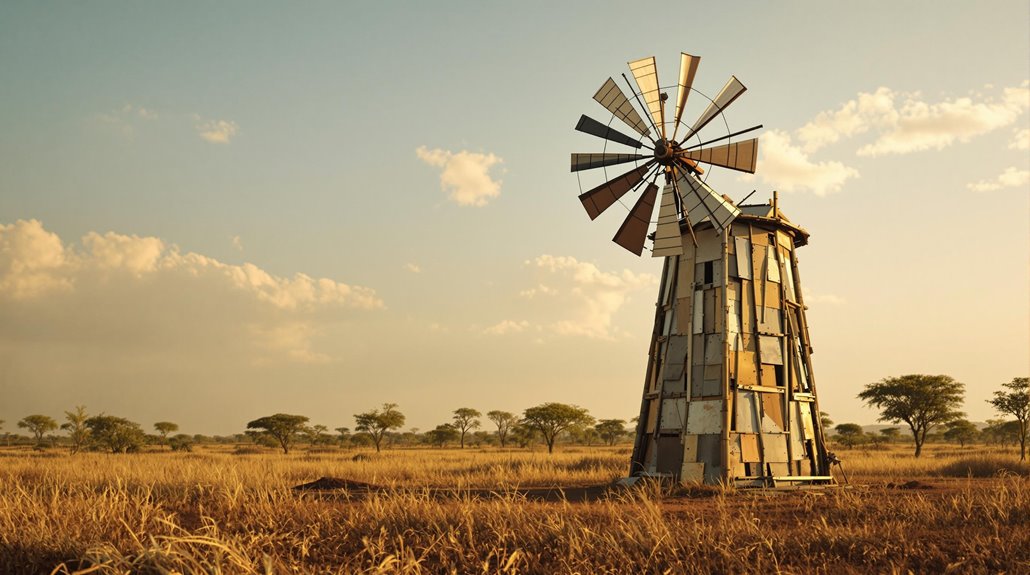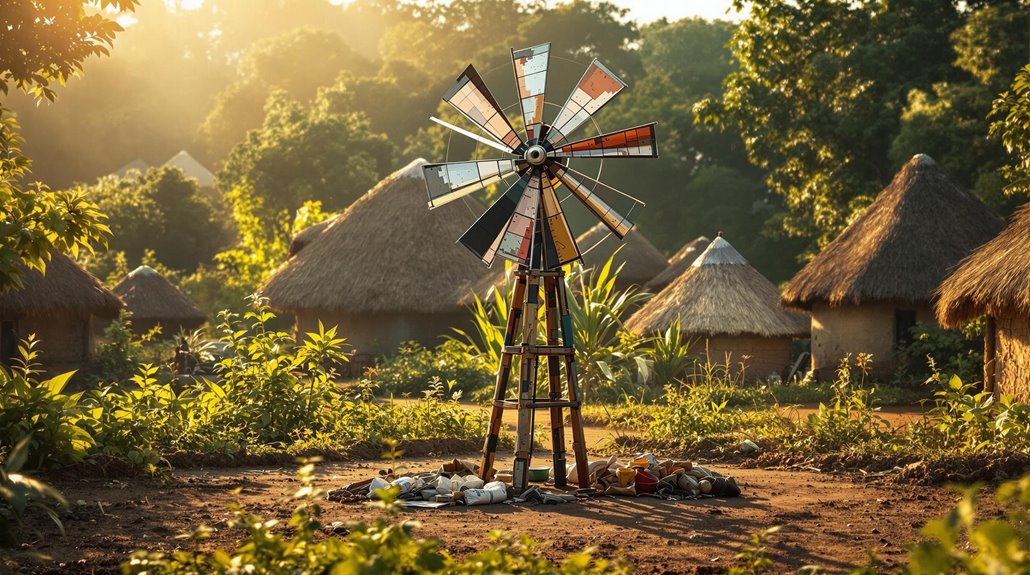William Kamkwamba’s Windmill: A Scrap Yard Creation That Lit Up a Village
Like Edison's first light bulb illuminating the darkness, you'll find that William Kamkwamba's story isn't just about a windmill—it's about defying impossibility with determination. You've probably seen countless tales of innovation, but this one stands apart: a 14-year-old boy in Malawi who turned bicycle parts and scrap metal into his village's beacon of hope. What makes this story particularly compelling isn't just the ingenuity behind the 500W windmill, but the ripples of change it created in a community that once called him crazy.
A Dream Born From Desperation

While Malawi suffered through a devastating drought in 2001-2002, 14-year-old William Kamkwamba faced the harsh reality of dropping out of school when his family couldn't afford the $80 tuition.
In his village, where poverty and hunger had become daily struggles, Kamkwamba refused to let his dreams of education die. Instead, he turned to the local library, where he discovered an American textbook that would change his life. He would spend countless hours at the community library, borrowing books that fueled his curiosity.
Despite being unable to read English, his perseverance led him to study the illustrations in "Using Energy." The images of wind turbines captured his imagination, sparking an audacious plan born from desperation: he'd build his own windmill to power his family's home. His early fascination with mechanics began when he believed small people lived inside radios.
Though his neighbors and parents dismissed his vision, Kamkwamba's determination would prove stronger than their doubts.
Turning Scraps Into Power
Armed with nothing but determination and discarded materials, Kamkwamba transformed local junk into an engineering marvel. From blue-gum trees to bicycle parts and PVC pipes, he repurposed renewable materials to craft a 39-foot windmill that would change his village forever. Just like the high school students in New Jersey, he saw the potential in materials others considered junk.
Using flattened plastic pipes for blades and fence posts as shafts, he constructed a power generator capable of producing 500W in strong winds. His tower legs were cemented into the ground to ensure maximum stability against strong gusts.
The windmill now powers multiple light bulbs, a TV set, and a radio – eliminating the need for costly paraffin lanterns. His innovative approach to recycling local materials hasn't just brought electricity to his home; it's inspired neighboring villages to rethink their approach to power generation.
The Village That Doubted, Then Believed
Despite his neighbors' initial ridicule, Kamkwamba's determination proved stronger than their skepticism. When he first started building his windmill, villagers called him "misala" (crazy), and even his family thought he was wasting time.
Without a word for "windmill" in Chichewa, the concept seemed foreign and impossible to many. Standing at 39 feet tall, his largest windmill became a testament to his ingenuity. Struggling through a devastating drought and famine, his resolve to find a solution only grew stronger.
But skepticism transformed into wonder when the first light bulbs flickered to life. You'd have seen the community's belief cultivated as Kamkwamba's creation powered TVs, radios, and allowed his sisters to study after dark.
The windmill became a local attraction, with neighbors trekking to charge their phones. What was once mockery turned to admiration, as the village handyman even attempted to replicate the design.
Through innovation, Kamkwamba hadn't just created electricity – he'd illuminated minds.
From Local Hero to Global Inspiration
After intriguing his village with the windmill's success, Kamkwamba's story caught the attention of TED conference director Emeka Okafor, who invited him to speak at TED Global 2007 in Tanzania. His talk showcased how community resilience and renewable energy could transform lives, catapulting him onto the global stage.
Using leftover materials and bicycle parts from local scrap yards, he built his first working windmill against all odds.
Initially met with skepticism, his neighbors would eventually seek to charge their phones at his home.
You'll find his journey documented in major publications like the Wall Street Journal and on The Daily Show with Jon Stewart.
His bestselling book "The Boy Who Harnessed the Wind" and its Netflix adaptation, directed by Chiwetel Ejiofor, have inspired millions worldwide.
TIME magazine named him among "30 People Under 30 Changing The World" while he pursued his education at prestigious institutions like Dartmouth College.
His story continues to influence universities and communities, proving that innovation can spark from anywhere, even a rural village in Malawi.
Building a Legacy of Innovation in Malawi

While Kamkwamba's personal success story captivated global audiences, his lasting impact on Malawi took root through the Moving Windmills Project, founded in 2008.
You'll find his vision of community empowerment reflected in the organization's thorough approach to development across Kasungu.
The project's sustainable practices extend beyond energy initiatives, touching every aspect of daily life. You can see this in their solar power installations, water well systems, and agricultural programs that enable multiple harvests yearly. During his early years on his family's farm, he witnessed how crop failures devastated communities, driving his passion for agricultural innovation.
They're transforming education through school renovations and learning resources, while the planned Innovation Center promises to nurture future problem-solvers. With 67% dropout rates plaguing primary education in Malawi, these educational initiatives are critically needed.
Through these initiatives, Kamkwamba isn't just sharing knowledge – he's building a framework for lasting change that empowers Malawians to create their own solutions to local challenges.










